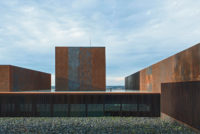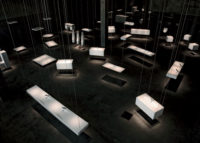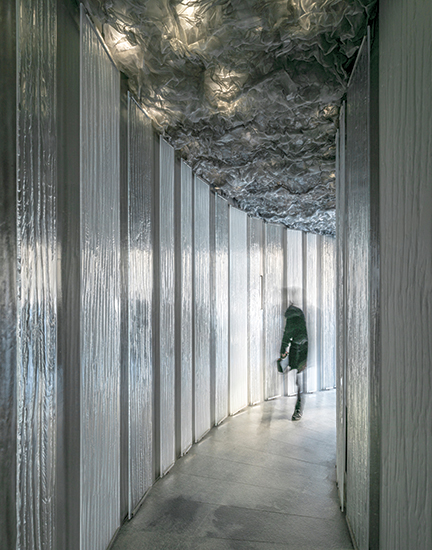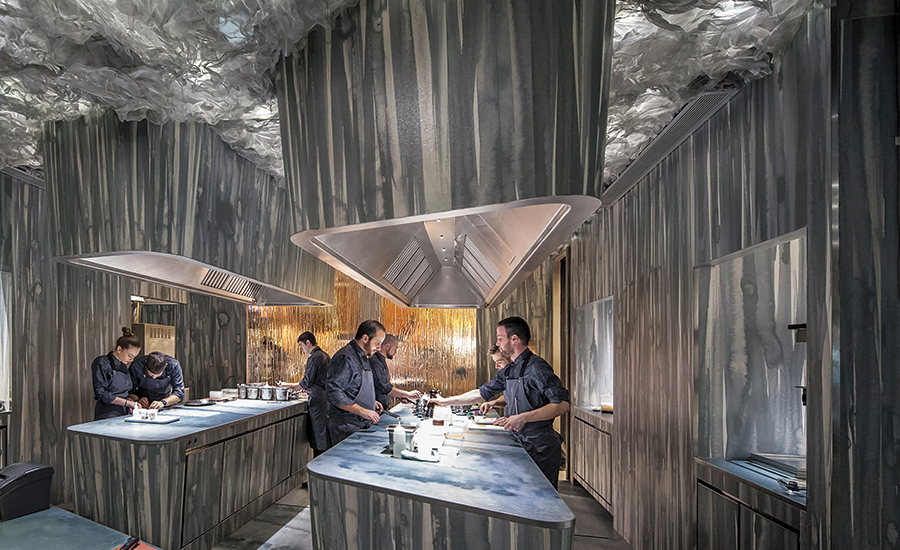Enigma Restaurant by RCR Arquitectes and Pau Llimona
Barcelona

Inside, the curving entry ramp offers a disorienting transition. Walls of sintered stone are faced with molded-glass panels for added shimmer.
Photo © Pep Sau

Enigma occupies the raised ground floor of a nondescript office building in central Barcelona. Guests gain access via a PIN code.
Photo © Dámaso Pérez

Molded glass screens add to the mystery of the spatial layering, within the interstitial spaces, and between the dining room and kitchen.
Photo © Pep Sau

The dining room, with sintered stone floors and walls veiled in glass, has stormy ceilings of crumpled steel mesh with LEDs. The architects designed the clear resin furniture and waitstaff uniforms.
Photo © Pepo Segura

Surfaced with sintered stone, the kitchen is visible to diners. Rear glazing screens it from the workshop where new dishes are tested.
Photo © Dámaso Pérez

Surfaced with sintered stone, the kitchen is visible to diners. Rear glazing screens it from the workshop where new dishes are tested.
Photo © Dámaso Pérez

The Teppanyaki Grille, one station of the peripatetic meal, is lit from above with subtle accents of red. (Other stations feature blue and lilac light.)
Photo © Dámaso Pérez

Image courtesy RCR Arquitectes and Pau Llimona








The design concept for Enigma, an avant-garde culinary venture in Barcelona, was to “create a world of its own, without references, to help you open yourself to a cuisine that also doesn’t want to work with known references,” says Carme Pigem, a partner of RCR Arquitectes. “We wanted to let your feelings and emotions be carried away by complete sensuality, as if in a cloud.” The architects, who are this year’s recipients of the Pritzker Prize, cite the cloud-making installations of Dutch artist Berndnaut Smilde as a point of inspiration.
Additional Content:
Jump to credits & specifications
Their first move was to seek spatial openness, depth, and ambiguity in the layout. The loosely defined, organically shaped spaces flow into one another, leading off in every direction, including through much of the open kitchen. Spaces are delimited by small sections of wall, which frame the spatial layers rather than enclosing them, and more diffusely by runs of narrow, freestanding panels of molded glass, which can pivot for different degrees of enclosure.
In the same spirit, the finishes depart from the minimalist palette typical of RCR’s work. For this project, the architects used busier, textured surfaces to create an overall atmosphere that is indeed a bit watery, something like a gray, rainy day. Walls, floors, and counters are clad with sintered stone, a manufactured material produced from dry sands that are compressed and fired at high temperatures. The slabs, up to 10 feet long, are grayish or silvery in color and have a slightly reflective surface. The architects imprinted the floors and walls with the subtle organic forms of watercolors they created for this project. The walls have an additional textural layer provided by the same glass panels used for the spatial dividers. Molded with vertical cords and veins, these transparent sheets create streaky refractions of light, as if it were raining. This effect is particularly intriguing at the windows, which are covered with larger sheets of the glass that convert the changing colors of passing cars and stoplights outside into a shimmering, evanescent presence.
The ceiling is a spongy membrane of stainless-steel mesh, crinkled to gain a cloudlike density and with the light from a grid of LEDs above it poking through in small bursts. The architects designed the chairs and tables in clear reinforced resin, which they chose for its warmth compared to glass. The resin refracts the light from the ceiling spots to glow from within, converting the furniture into luminous points of focus in the spaces. The overall ambience is unconventional but discreet, offering an intriguing backdrop for the main event of the food.
Enigma heads a small fleet of Barcelona restaurants created by Albert Adrià, the brother of Ferran, the chef who revolutionized contemporary cuisine at the mythic El Bulli restaurant, which closed in 2011. Albert was the pastry chef at El Bulli, and he casts Enigma as its successor, an outpost of high-stakes gastronomic adventure. Each night, a small group of diners makes its way through a sequence of stations to sample 35 to 40 dishes. You may find yourself before a morsel of transmogrified grapefruit served on a fragile shiso leaf, a sea anemone dusted in Earl Grey tea, a sliver of wild pigeon, a dab of foamed horseradish, or a bite-size piece of squid briefly seared over a Japanese grill.
Working together, Adrià and RCR decided to spread the dining experience throughout the space in a rather digestive process, a ceremonious procession guided by the attentive waitstaff. The curving entry hall circles 180 degrees and up a few steps to create a disorienting transition into the restaurant. Guests are received in the Welcome Area and led to the Cava (or wine cellar), the Cocktail Bar, and past the open kitchens to the Grille, sampling a series of drinks and snacks at each station. In the sit-down dining room they are treated to a more extended session of the same, before being ushered out of the RCRdesigned space and into a back room that recreates the black-leather, stained-wood decor of 41º, the cocktail bar that first brought Albert to prominence. Here guests can linger over a final drink before slipping out a back door to the street.
The RCR-designed spaces share the same finishes and overall ambience, but the incongruous addition of the 41º bar was obviously the client’s idea. Pau Llimona, a former RCR staff member who collaborated with them on the project, defends the immersive wholeness of their design: “We didn’t want to create a roller coaster of ‘oohs’ and ‘aaahs.’ We wanted to bring people into a special world and for them to come out of that world and reflect on it.”
Underlying this experiential approach is an idea about the relation between architecture and the senses that informs all of RCR’s work, and that combines the Zen-inflected spirituality they imbibed on an early visit to Japan with an earthy, country sensuality. This spirit is perhaps most in evidence in their interventions at Les Cols restaurant in their native town of Olot, in remote northern Catalonia, and especially in the sleeping pavilions they added to the restaurant’s garden, which are built entirely of glass—floors, walls, ceilings, and garden fences. Near their studio of some 50 architects in Olot, RCR is now developing a research lab dedicated to exploring these ideas. Pigem reports, “We want to investigate the essential qualities of space, and how it relates to life—the spaces we need to help us understand life in its essence.” Perhaps this quest is the true enigma that lies at the heart of their design for Albert Adrià.
CreditsArchitect: RCR Arquitectes — Rafael Aranda, Carme Pigem, Ramon Vilalta, principals; Pau Llimona
Architect of Record: SGA Arquitectos
Engineers PGI Ingeniería (mechanical)
Contractor: Pujalte Construcciones (builder)
Consultants: Marbres Rodón (sintered stone); Artec3 (lighting); See Sound (audio)
|
SpecificationsSintered stone TheSize (Neolith)
Davide Groppi
Metálicas Olot
Cricursa
LG; Instalaciones Gava
Complet Hotel; Frigicoll
Art&Design
CSTY |










